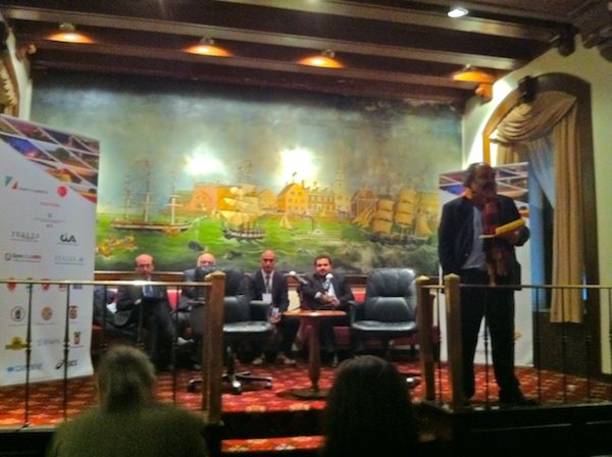


With his boundless knowledge of Italy and Italian food, Fred Plotkin [2] was the obvious choice as moderator of the seminar: “The Italy That Still Runs – Genuine Passion”. The event was organized by Casa Italia Atletica [3], and was part of a series of events held from November 4 to November 6 to promote genuine and healthy Italian food. Among the other appointments, an event at the Italian Government Tourist Board (ENIT [4]) in New York on November 4 with representatives of several Italian regions who described the zones they come from in relation to sport and food.
The seminar, held at Jolly Madison Tower Hotel [5], featured the same delegations present the evening before at ENIT – from Ascoli Piceno [6], Reggio Calabria [7], Molise [8], Province of Siena [9], Friuli Venezia Giulia [10] and Lazio Fontana di Papa - introduced and moderated by Mr. Plotkin. The conference lasted the entire afternoon and, during the halftime break, the guests were able to sample some of the best products Italy has to offer both in the gastronomical and enological fields. A special mention is deserved by the many bergamot based desserts (bergamot is a citrus fruit found along the coast near Reggio Calabria, and it is best known for being the ingredient that gives Earl Grey tea its distinctive flavor) and the superb Sicilian cannoli prepared on the spot. For those who still wanted more, a pasta party was the final treat of the event. A very Italian icing on the cake.
During his introduction, Plotkin talked about what makes Italian food truly genuine and how to preserve its heritage. He started off reminiscing of a time, 25 to 30 years ago, when Americans thought Italian food was made up of basically two ingredients: tomatoes in the South, and cream and cheeses in the North.
Of course, it is now common knowledge that Italian cuisine is made up of countless local culinary traditions, so many that it is impossible to categorize them in one simple frame. When American chefs realized the existence of this variety of products, they started importing them to the United States and utilizing them in their own creations, often using them in a very different way than the Italians do.
Plotkin explained that chefs want to make their Italian recipes more appealing to the American palate and how this is unfortunately threatening to make genuine Italian food an ever rarer breed in the US. In order to preserve true Italian heritage in the American kitchen, according to Plotkin, restaurants need to educate their clients: Italian chefs in the USA have to be “ambassadors of their own regions”.
Another issue that Italian restaurants have to overcome is importation regulations. The gargantuan amount of rules – about specific Label guidelines, packaging standards and inspections, to name a few - imposed by American authorities on imported products makes it very hard for local restaurateurs to import all the products they need. Actually, only a minimal part of the products available in Italy reaches this side of the Atlantic.
In addition to these issues, Italy as part of the European Union [11], must follow the guidelines the Union’s administration designs to make the European economy more efficient. A true Italy lover and connoisseur, Plotkin pointed out how it often happens that while these rules indeed make the European economy more efficient, they threaten the local character of gastronomical products as well. For example, if there is a surplus of milk in Holland and that milk is shipped to Italy and used to make Parmigiano, the resulting product is different that the original, as those cows are of a different variety and graze on a different grass, thus their milk has a different aroma.
Plotkin further expanded on this concept saying that globalization itself is a force that somehow flattens the quality standards of products all over the world, and as such it can be a threat to local artisanal high quality food. An example of how globalization, coupled with the lack of information on the American market, can produce a negative result is that of balsamic vinegar [12]. This product is made following extremely strict standards in a small area around the city of Modena [13]. Rising demand for this condiment became so extreme that it led many companies, often from anywhere but Italy, to create imitations of balsamic vinegar. The same thing happened with Parmesan (the fake Parmigiano Reggiano [14]).
The bottom line, according to Plotkin, is that Italian people always try to exceed standards. When the DOC standard was introduced, many Italian companies created products far exceeding the minimum standard requested for DOC denomination. This effort to reach the best possible quality, together with a deep connection to history and traditions – “Italy is the place of memory” – makes Italian artisanal products special. Plotkin emphasized that American consumers deserve to appreciate this form of art the way it was originally created.
Source URL: http://newsite.iitaly.org/magazine/events/reports/article/italy-still-runs-genuine-passion
Links
[1] http://newsite.iitaly.org/files/plotkin1290804735jpg
[2] http://www.fredplotkin.com/fredplotkin.com/Home.html
[3] http://www.casaitaliaatletica.it/
[4] http://www.italiantourism.com/
[5] http://www.jollymadison.com/
[6] http://www.comune.ascolipiceno.it/flex/cm/pages/ServeBLOB.php/L/IT/IDPagina/1
[7] http://www.comune.reggio-calabria.it/on-line/Home.html
[8] http://en.wikipedia.org/wiki/Molise
[9] http://en.wikipedia.org/wiki/Province_of_Siena
[10] http://www.regione.fvg.it/inglese/
[11] http://europa.eu/index_en.htm
[12] http://www.balsamico.it/
[13] http://turismo.comune.modena.it/index-en.php
[14] http://www.parmigianoreggiano.com/default.aspx